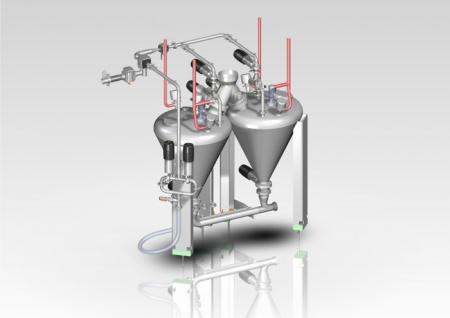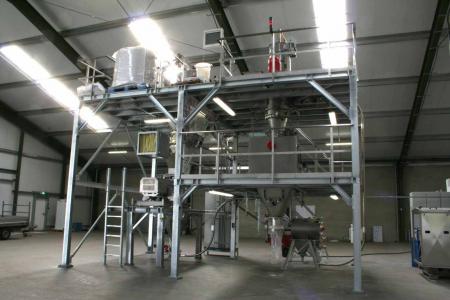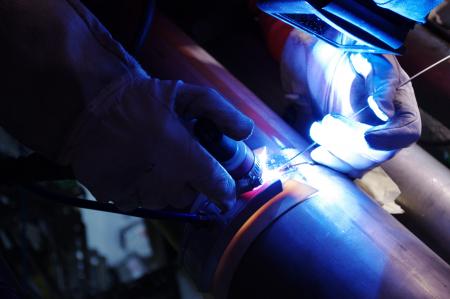This article discusses:
- The properties that influence the choice of pipework
- The influence of a pipe diameter
- The importance of good welding
- The use of hoses for flexibility
- The effect of curves on transport
- The different types of valves
The experts at Dinnissen Process Technology are available to answer all your questions:
Get in touch with Juul Jenneskens 077 467 3555
Properties that influence the choice of pipe work
Of course, choosing the entry point, the way the air is moved and the receiving point is important to the operation of the system. But the choice of switches, pipework and bends to be used is also essential for the proper functioning of a pneumatic transport system. Certainly if the powders being transported can be fragile, greasy, abrasive or cohesive, a good choice can be essential for the proper functioning and life of the system.
Ultimately, the choice of pipe diameter also affects the capacity of the system. With a pipe diameter of 80 mm, the surface of the pipe diameter is 0.0050 m2. If the pipe diameter is increased to 100 mm when selecting the system, the surface area of the pipe diameter will be 0.0079 m2. This seems to be a marginal difference, but increasing the pipe diameter by 25% reduces the air speed by 56.25%. As a result, other choices will also have to be made to achieve the required air speed. This therefore has an impact on both the CAPEX and the OPEX. The initial investment will be higher by increasing the pipe diameter, but also the energy costs during the lifetime will increase considerably. Ultimately, this is only part of the choices that must be made regarding the pipework. Aspects such as material to be used, wall thickness, surface treatment, connections of pipes and bends, bends to be applied and any steps in the diameter of the pipework are considerations that must be made. All these choices are influenced by the product, the pipe route to be taken, the desired capacity and the type of pneumatic transport that is used. The way in which the pipes are connected will ultimately also have an impact on the way in which pipework can be cleaned and any blockages can be removed.

Dense phase transport
The influence of the pipe diameter
With both Dense Phase blow and suction transport, the expansion of the air will increase the transport speed of the powder to be transported. By gradually increasing the diameter of the pipework, the transport speed can be somewhat stabilized. An increase in the pipe diameter can also be used to reduce the speed at the receiving point in a vacuum transport. The powder will then not fly into the receiving point at a high speed. This is because the pressure decreases rapidly with a volume increase. This is proven with the formula:
If V2 is increased, P2 must decrease. This decreases the speed of the powder. The following calculation example will clarify this. If the product in the pipe work with a diameter of 100 mm has a departure speed of 20 m / sec, the speed will be increased by 25% as a result of a pressure drop of 250 mBar. The speed of the product will then be 25 m / sec. If now the pipe diameter is increased to 110 mm, the new speed of the product will be 20.66 m / sec. An important note when using stepped pipes is that the product speed should never be lower than the departure speed. So if in the previous example the pipe diameter were increased to 125mm then the speed would be 16m / sec. This is lower than the departure speed of 20 m / sec. This will cause the product to settle in the pipe and cause blockages.

If high-quality welding is required for pneumatic transport, this requires highly qualified welding specialists
The importance of good welding
In the food industry and pharmacy, stainless steel piping is generally chosen from a hygienic point of view. Not only the chosen pipework is important for a good system. The welding of pipework must also meet a number of requirements.
These welding surfaces in stainless steel pipes are often the parts that wear out first and as a result of which hygiene is also compromised. Ideally, in order to delay that wear as long as possible, the welded parts should meet all of the following points:
- A complete penetration,
- No cracks or porosity,
- No burn-throughs,
- Proper fusion and alignment of pipework,
- Attention for internal discolouration, cavities and / or spheres and / or inclusions,
- Surface roughness must not increase,
- The pipework must not show any irregularities,
- Welding should not change the material mettalurgically.
If high-quality welding is required for pneumatic transport, this requires highly qualified welding specialists.

Welding of pneumatic piping
The use of hoses for flexibility
Hoses can also be used for flexibility of the system. For example, hoses are used when connecting bulk trucks to a pneumatic transport system. Flexible hoses can also be used in pneumatic transport. With Dense Phase pneumatic transport, flexible hose can be used to prevent blockages in the pipe. Particularly with fine powders, powders with a high fat content, or sticky powders, the powder in steel pipes can adhere to the wall and build up a layer. This layer can gradually increase in thickness until it has built up to the point where it clogs the pipeline. This is prevented when such powders are transported through a thin-walled rubber hose. The natural movement and bending of the hose due to the pulsations of air pressure and product displacement is generally sufficient to prevent powder from building up in the pipework. The hose should be mounted so that it can move freely but has enough support to keep it reasonably straight.
The effect of bends
The routing of a pneumatic conveying system is flexible because bends can be used. Nevertheless, bends should be avoided as much as possible. Each bend creates extra resistance in the pneumatic transport, which increases the required air pressure. As a rule of thumb, each bend is equal to 6 meters of pipework to determine the pressure drop. In order to avoid bends, one could consider placing pneumatic transport at an angle. However, tests show that this is energetically very unfavorable. The effect is highly dependent on the product to be transported, but more air pressure and air flow will be required to transport the product. In addition, bends are an important cause for breakage in fragile products.
Preventing wear
A frequently occurring property of products to be conveyed pneumatically is abrasiveness. This causes wear in the pipework. This can be taken into account by using a larger wall thickness. Particular attention should be paid to the bends used for this pipework. During air transport, the powder particles will relatively often hit the walls of the bends. By applying special basalt curves or ceramic-coated curves, the wear resistance of the curves can be significantly improved. Another solution is specially designed curves. The bends are designed in such a way that due to turbulence the product to be transported does not hit the wall but the other transported products. The advantage of this is that the wear of the bends will decrease considerably. However, it also has disadvantages, as the turbulence in the bend also creates a pressure drop. In addition, with perishable products it is not clear how long they will remain in the system. Dinnissen has developed the patented Aeolus curve for this. Due to the special design of this bend, it is wear-resistant, product growth in the bend is prevented, the pressure drop is minimal and perishable products do not accumulate in "dead zones". These curves have been successfully applied countless times with abrasive products such as lactose.
The different types of valves
In pneumatic transport, a wide variety of valves are used to isolate the product flow. The following valves are used in pneumatic transport:
Discharge valve: These valves are fitted with a slide in the product flow. These valves can cause turbulence in the product flow if they are not perfectly smooth internally. These valves are vulnerable during opening and closing in a product flow.
Ball valve: with these valves a ball rotates with a passage in the product flow. This makes this valve particularly vulnerable in product flows where abrasive powders are transported.

Name: Juul Jenneskens
Advisor
Please feel free to contact me if you have any questions about this subject. My team of colleagues and I are ready to answer!
Get in touch with Juul Jenneskens 077 467 3555 [email protected]
Do you prefer to request a consultation directly?
